Red Harvest, Yojimbo, A Fistful of Dollars: Remaking the Remake
The American Western was revitalised by an Italian director inspired by a Japanese filmmaker with a love of hardboiled fiction.
This is the strange international pedigree of the ground-breaking A Fistful of Dollars. Sergio Leoni, a man who neither spoke English or who had visited the United States, single-handedly redefined a quintessentially American setting.
(click on PDF icon, above right, if you prefer back script on white)
He based the plot on Akira Kurosawa’s Yojimbo. The story of a masterless samurai who finds 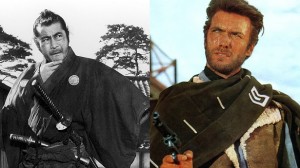 himself in a town between two gangs vying for control.
himself in a town between two gangs vying for control.
Which in turn was lifted from Dashiell Hammett’s Red Harvest. Kurosawa acknowledges Hammett’s novel The Glass Key as an inspiration for Yojimbo. In particular, the torture scene is taken from the 1942 film version, right down to the hulking henchman that does the beating (which Leoni then copies for Dollars).
Overwhelmingly, though, it is the plot of Red Harvest Kurosawa uses. It’s a brutal one. The nameless Continental Op arrives in a town called Personville (nicknamed ‘Poisonville’ by everyone who’s been there) and finds himself in the middle a four-way tussle for control by various criminal elements. The Op proceeds to – using calculated, merciless, and wilfully violent methods – set the four factions against each other. He starts a war, and does not stop until nearly every criminal is dead, and parts of the town have been razed to the ground.

This is essentially the plot of Yojimbo and Dollars.
Indeed, A Fistful of Dollars goes further, copying many of the scenes and even dialogue directly from Yojimbo. So close, in fact, Kurosawa sued Leoni. They eventually came to terms – Kurosawa received the Japanese distribution rights to Dollars. If he’d been better informed, Leoni simply could have claimed he’d been inspired by Hammett’s Red Harvest.
The surface similarities between Red Harvest, Dollars and Yojimbo are worth focusing on briefly:
The Continental Op is never given a name; the Man with no Name, well, doesn’t; and the Ronin from Yojimbo lies about his name – when they ask him, he looks out the window and sees a mulberry field, and so calls himself Thirty-Years-Old Mulberry Bush.
None of the protagonists make any money. The Continental Op turns down bribes all over the 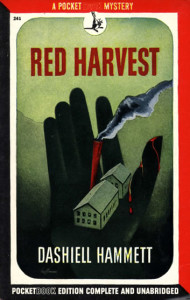 place, Eastwood leaves with a fistful of nothing, and Toshiro Mifune’s ronin gives all his money to a family to help them escape the town. Money is only ostensibly the reason each gives as the motivation for his actions. But in all three cases money has little, if anything to do with their motivations.
place, Eastwood leaves with a fistful of nothing, and Toshiro Mifune’s ronin gives all his money to a family to help them escape the town. Money is only ostensibly the reason each gives as the motivation for his actions. But in all three cases money has little, if anything to do with their motivations.
Eastwood mimics many of the facial expressions and habits of Mifune, smokes a cigarillo (where Mifune always chews on a toothpick) and wears the now-famous poncho, which is a clear acknowledgment of the yukata worn by Mifune.
A line of dialogue from Yojimbo, “they can only hang you once,” is also the title of a Hammett short story written in 1932, though this is probably just coincidence.
The violence in all three is brutal and unrelenting.
There is a scene in both Yojimbo and Dollars where the hero looks on, hidden, wounded, as a massacre takes place. On the one hand, the viewer feels a kind of sympathy for those murdered (the husband, wife, and son who lead one faction, and all their men) and feel for the damaged hero. And yet, the thought still nags: the hero is responsible for it. The hero willed the violence. The dead may be the corrupt, the killers, the criminals – but it is a body count he cynically, even sadistically, brought about.
A Philosophical Unease
While these surface similarities are interesting, the far more pertinent question is this: how can the same story, told in three different countries, three decades apart, be compelling in every instance? Why is the audience in these different cultural and temporal contexts yet drawn to these two movies and this novel?
These three stories have a shared philosophical core, one the goes to the heart of modern civilisation.
The private eye, the masterless samurai, the gunslinger: each the loner who works to their own, often opaque, code; who exists somewhere between the demimonde of the criminal underworld and ‘civilised’ society.
They are, in other words, the archetype best suited to playing the ‘existential’ individual as 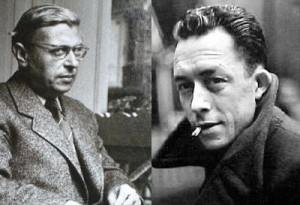 articulated by French philosophers Sartre, Camus and others in the 30s (Hammett wrote Red Harvest in 1927 and his last published novel, The Thin Man in 1934; Sartre published Nausea in 1938; Camus The Stranger in 1942).
articulated by French philosophers Sartre, Camus and others in the 30s (Hammett wrote Red Harvest in 1927 and his last published novel, The Thin Man in 1934; Sartre published Nausea in 1938; Camus The Stranger in 1942).
Existentialist philosophy argues that existence precedes essence. In other words, we need not be determined by the arbitrary and absurd rules of the world we are born into, and once we realise this, we can exercise our freedom according to our own codes and values. The core of existentialist philosophy is as follows: life is meaningless, only we can give it meaning.
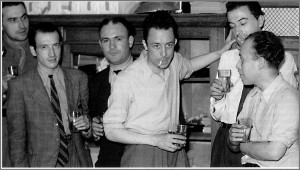
The rise of existentialist and noir literature around the same time during the inter-war period was no accident. This is a world that saw the aftermath of the Great War, the depths of the Great Depression, the rise of fascism, and the key beliefs of enlightenment ideals: learning, civilisation, and progress, shaken to their very core.
The elegant and sparse stories of Dashiell Hammett in the 30s explored the moral vacuum of an era. The crony capitalism of inter-war America, the unchecked power of business and political elites and their collusion in perpetuating a corrupt system, the crushing underfoot of the dreams of regular people. It is a bleak and violent world where a man or woman has nothing but their own integrity and abiding cynicism.
Kurosawa said of Yojimbo that he specifically that he wanted to critique modernity, in particular capitalism and new technologies. Which is why the handsome, fearsome, main bad guy in 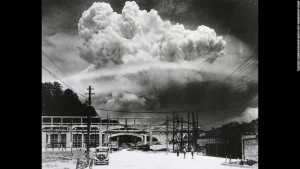 Yojimbo turns up with a pistol halfway through the movie (everyone else has swords).
Yojimbo turns up with a pistol halfway through the movie (everyone else has swords).
Yojimbo, released in 1961, came at a time when Japan was struggling with modernity, over the changes wrought in the country since the end of the disastrous Second World War. The occupation by and later alliance with the United States changed the cultural tenor of the nation, rejecting old values and social structures. For good reason, given Japan’s role on the war.
Still, an anxiety at what progress meant was warranted.
What Red Harvest and Yojimbo have in common is an unease with modernity. With the alienation of capitalism, with society slowly shedding itself of long-held belief systems, with a new class and new mentality coming to rule.
Of A Fistful of Dollars, Leoni explained: “I see the history of the West as really the reign of violence by violence.”
By the 1960s, as the national confidence of 1950s USA began to erode, so Westerns changed tone, portraying instead a brutal, Hobbesian existence. Sue Matheson has argued that Westerns of this area: “critique capitalism and anticipate the revision of frontier American history…In these movies, white settlers are not portrayed as heroic figures, but as predators and social misfits.” And furthermore: “…in the American West is the modern notion that in America, the time for heroes and heroism ended long ago.”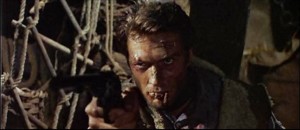
The hardboiled – whether western, detective, or samurai – explore the integrity of the individual in this amoral world. Noir characters don’t concern themselves with justice or meaning: neither exists. The noir character accepts the corruption of the system and knows they cannot change it; however, they simultaneously refuse to live by its rules.
Raymond Chandler claimed in a famous essay that the noir hero was the ‘modern knight’. This claim has been the go-to for many wishing to use a pithy soundbite to describe the subgenre. One problem is this: it’s bullshit.
Chandler was the inferior writer to Hammett (the same people who say otherwise are the same people who think noir is about some kind of gritty chivalry). As James Ellroy argued: “Hammett’s vision is exponentially more complex than that of his near-contemporary Raymond Chandler. Chandler wrote the man he wanted to be – gallant and suffused with a lovely satirist’s wit. Hammett wrote the man he feared he might be – tenuous and sceptical in all human dealings, corruptible and addicted to violent intrigue.”
Dashiell Hammett, in his real-life job as a private detective for notorious union-busting fascists, the Pinkerton Agency, witnessed the underbelly of the American dream. Again, Ellroy on Hammett: “He stealth walked through a world of laudanum-guzzling grifters and bent cops susceptible to night sweats and visions. It was the Boom. The mechanized horror of the Great War roiled in recent memory.”
Hammett saw how corruption was seamlessly integrated into the body politics, he saw the lie of progress for what it was: the creation of an oligarchy, their usurpation of the political system, the exploitation of the working class and the marginalised (or in the case of the private eye, the co-opting of working class men to do the work of the elite).
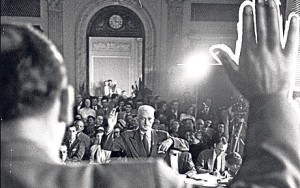
His first novel, Red Harvest, is a remorseless bloodbath in a Montana mining town, rooted in the real-life evens of labour unrest and industrialization. The protagonist, The Continental Op, is a ‘hired man’ used to protect society from crooks and gangsters, yet at the same time an instrument for the venal and corrupt to protect their rule.
The struggle of the noir hero is not to be good, or chivalrous. If conventional definitions of good include not being an alcoholic or gambling addict; if it includes obeying the law and not killing criminals; if good means not sleeping with married women (or men), and not being amoral, unfeeling or cynical – then noir heroes are not good. Noir heroes are frequently cruel, selfish, and violent.
Rather, what is key is that the noir protagonist acts in authentically, in the Sartrean sense of refusing to bow to social forces and adopt values they despise. Refusing at every turn to disown their own freedom. It is never taking the easy road.
It would have been easy for Deckard to betray Rachel in Blade Runner. It would have been easy 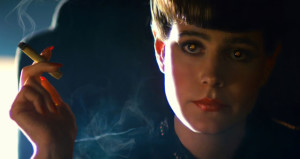 for Jake, in Chinatown, to shirk from a fight against the most powerful man in the state. It would have been easier for Sam Spade in The Maltese Falcon to take the bribe and be with the woman he loved. Easier still for the Continental Op to take money from his corrupt employer in Red Harvest, rather than start a war against dangerous gangsters. Easy for the ronin to take the gold and run in Yojimbo.
for Jake, in Chinatown, to shirk from a fight against the most powerful man in the state. It would have been easier for Sam Spade in The Maltese Falcon to take the bribe and be with the woman he loved. Easier still for the Continental Op to take money from his corrupt employer in Red Harvest, rather than start a war against dangerous gangsters. Easy for the ronin to take the gold and run in Yojimbo.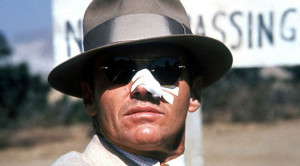
The noir antihero perversely becomes more intent on pursuing a case, or vendetta, or in simply finding an answer, the more they suffer. Indeed, the will to freedom, and their capacity to act in good faith within an irredeemably corrupt system, is almost nihilistic.
Max Weber said: “the decisive means for politics is violence.” And this is the decisive means within noir, the triumph of violence. Not the violence, either, of the Samurai, the Private Eye or the Gunslinger. They are merely instruments. The violence inherent to the social order; violence as a logical endpoint in the reification of Hobbesian capitalist accumulation, torn free of the restraints of social mores or tradition.
The noir anti-hero resonates across time and culture because all times and cultures understand the venality of the powerful, the alienation of modernity, the absurdity of political rule by the worst among us. Noir resonates because a man or woman – no matter how flawed – who refuses to obey the rules of this system is a rare, and admirable, human being.
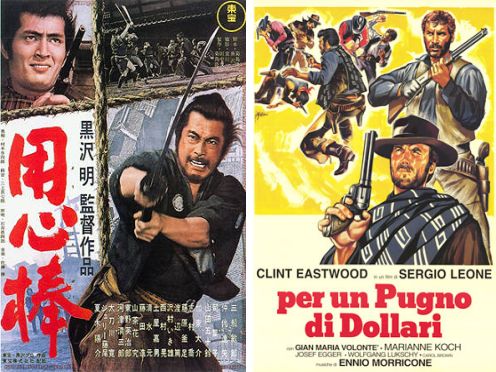
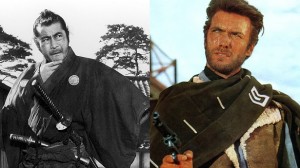
Love this, Tim.
Did not realize the connection between Kurasawa’s work and Hammett’s. Fascinating.
Cheers Shazza